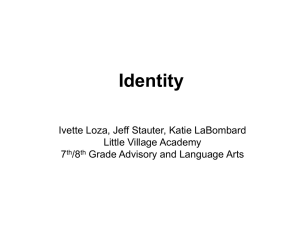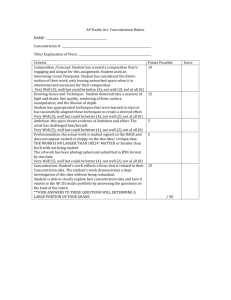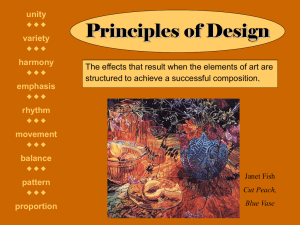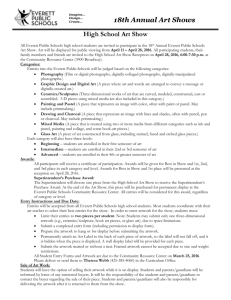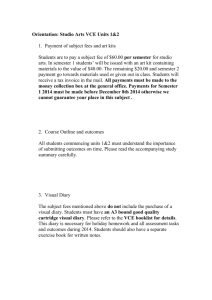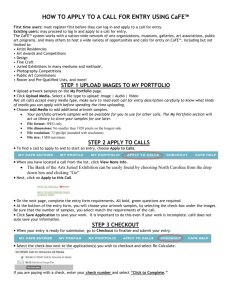Visual Arts
advertisement
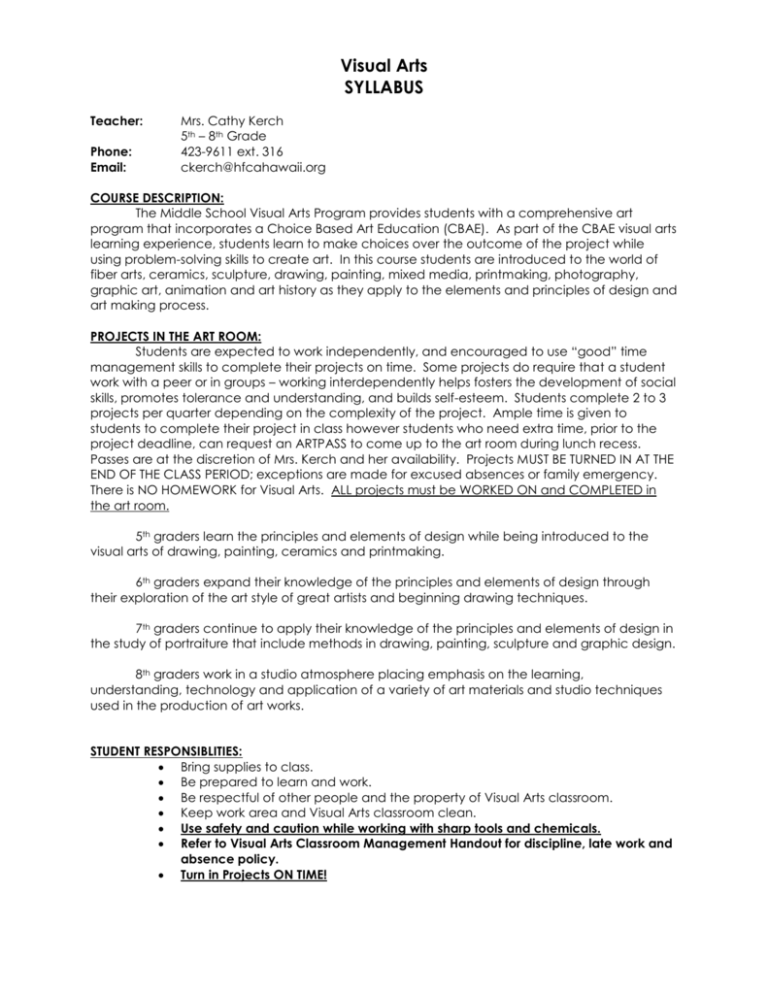
Visual Arts SYLLABUS Teacher: Phone: Email: Mrs. Cathy Kerch 5th – 8th Grade 423-9611 ext. 316 ckerch@hfcahawaii.org COURSE DESCRIPTION: The Middle School Visual Arts Program provides students with a comprehensive art program that incorporates a Choice Based Art Education (CBAE). As part of the CBAE visual arts learning experience, students learn to make choices over the outcome of the project while using problem-solving skills to create art. In this course students are introduced to the world of fiber arts, ceramics, sculpture, drawing, painting, mixed media, printmaking, photography, graphic art, animation and art history as they apply to the elements and principles of design and art making process. PROJECTS IN THE ART ROOM: Students are expected to work independently, and encouraged to use “good” time management skills to complete their projects on time. Some projects do require that a student work with a peer or in groups – working interdependently helps fosters the development of social skills, promotes tolerance and understanding, and builds self-esteem. Students complete 2 to 3 projects per quarter depending on the complexity of the project. Ample time is given to students to complete their project in class however students who need extra time, prior to the project deadline, can request an ARTPASS to come up to the art room during lunch recess. Passes are at the discretion of Mrs. Kerch and her availability. Projects MUST BE TURNED IN AT THE END OF THE CLASS PERIOD; exceptions are made for excused absences or family emergency. There is NO HOMEWORK for Visual Arts. ALL projects must be WORKED ON and COMPLETED in the art room. 5th graders learn the principles and elements of design while being introduced to the visual arts of drawing, painting, ceramics and printmaking. 6th graders expand their knowledge of the principles and elements of design through their exploration of the art style of great artists and beginning drawing techniques. 7th graders continue to apply their knowledge of the principles and elements of design in the study of portraiture that include methods in drawing, painting, sculpture and graphic design. 8th graders work in a studio atmosphere placing emphasis on the learning, understanding, technology and application of a variety of art materials and studio techniques used in the production of art works. STUDENT RESPONSIBLITIES: Bring supplies to class. Be prepared to learn and work. Be respectful of other people and the property of Visual Arts classroom. Keep work area and Visual Arts classroom clean. Use safety and caution while working with sharp tools and chemicals. Refer to Visual Arts Classroom Management Handout for discipline, late work and absence policy. Turn in Projects ON TIME! GRADING: Grades are based on the following: 10% - Class Participation (this includes but not limited to: question/answer contribution, following directions, being prepared for class, collaboration and cleaning up at the end of class) 30% - Class Work (this includes but not limited to: amount of effort put into a project and use of time management on project) 60% - Projects (Final Artwork, Tests, Understanding/Comprehension of Project and Essays) Grading is done by Rubric. Please see Attached Rubrics. **Peer grading is used to determine Participation and Class Work, when projects are completed in pairs or groups, but not for the Final Project Grade. SAFETY IN THE ART ROOM: In the Visual Arts classroom, students learn to work with various art tools that are used in the everyday creation of art. These tools include and are not limited to pencils, brushes, scissors, pins, needles, x-acto knives, cutting board, linoleum cutters, carving tools, wire cutters, pliers, screw drivers, hammers, electric drills, sewing machines, rust, paper cutter, sand paper, wire, foil, rollers, various types of clays, glazes, plaster, alginate, rubber cement, spray adhesive, turpentine, acetate, chalk, pastels, and paints (watercolor, tempera, acrylic, and latex). Every precaution and preparation is taken to provide students with proper instruction and safety gear prior to the use of these tools. Cleanliness is also an important aspect of art, as well as a means of safety for your child and all students who use the Visual Art classroom. Students are required to clean up their work area and tools before leaving the classroom using the following cleaners; Dove soap/water on brushes, mild detergent/water and/or Clorox Wipes on tables and a broom to sweep the floor. Every effort is made to provide your child with a safe environment to learn and work in however, accidents do happen even under the strictest supervision. Therefore, I am asking each parent discuss with your child the importance of listening and following directions when using these tools and cleaners in the Visual Arts classroom. If you do not wish your child to use one or more of these items please let me know and I will attempt to accommodate your child with an alternative tool, or provide him/her with a separate project from the rest of the class. Sincerely, Mrs. Cathy Kerch Visual Arts PLEASE CUT & RETURN THIS HALF TO MRS. KERCH: I HAVE READ AND UNDERSTAND THE ABOVE COURSE DESCRIPTION, STUDENT RESPONSIBILITIES AND GRADING POLICY FOR THE VISUAL ARTS PROGRAM. I HAVE READ AND DISCUSSED WITH MY CHILD THE SAFETY POLICY FOR THE VISUAL ARTS CLASSROOM AND CLASS MANAGEMENT POLICY. PARENT or GUARDIAN SIGNATURE: ____________________________________________ E-Mail:_____________________ STUDENT SIGNATURE: _____________________________________________ GRADE: _____ 5th Grade Art Rubric (Project Grade is based on Understanding and Use of E&P) Element Line Shape Color Texture Form Mass Space NI (50-74.99) Struggles/Fails to Understand Concepts S (75-84.99) Approaches Understanding none Some visual that approaches the concept without clear knowledge. none Some visual that approaches the concept without clear knowledge. none Some visual that approaches the concept without clear knowledge. Use of ONLY primary colors. none Some visual that approaches the concept without clear knowledge. none Some visual that approaches the concept without clear knowledge. none Some visual that approaches the concept without clear knowledge, flat looking work. none Some visual that approaches the concept without clear knowledge. G (85-92.99) Understanding E (93-100) Advanced Understanding Basic image that demonstrates understanding of the concept. Simple outline. Basic image that demonstrates understanding of the concept. Clear but elementary shapes like triangles, circles, and squares. Basic image that demonstrates understanding of the concept. Use of both primary and secondary colors only. Basic image that demonstrates understanding of the concept. Showing simple single texture. Basic image that demonstrates understanding of the concept. Clear but elementary forms, basic shading to suggest form. Basic image that demonstrates understanding of the concept. Some sense of mass through the use of form. Basic image that demonstrates understanding of the concept. Showing a basic use of space through form or shading. Example that shows a more advanced concept of the element, like using line to create suggest form through crosshatching, complicated edges, texture. Example that shows a more advanced concept of the element. Non outlined shapes, complex shapes, shapes that suggest form, use of shape motif... Example that shows a more advanced concept of the element, like the use of tertiary colors, color for texture, use of chromatic gray... Example that shows a more advanced concept of the element, like multiple textures, textures through color, organic textures. Example that shows a more advanced concept of the element. Shading that appears to vary in intensity and size, use of complex forms. Example that shows a more advanced concept of the element, like textures alluding to mass, or a strong use of form and shading. Example that shows a more advanced concept of the element, like the use of positive and negative space, or shadows on the surface under the object. 6th – 8th Grade Art Project Rubric Name of Project Elements & Principles of Design Craftsmanship & Neatness Time & Management Execution, Originality, & Uniqueness Requirements Name of Student 7 10 8 Planned carefully, made sketches, and showed an advanced awareness of the elements and principles of design. Student went above and beyond expectations The artwork shows that the student applied the principles of design while using one or more elements effectively. Student met expectations. The student did the assignment adequately, yet shows a lack of planning and little evidence that an overall composition was planned. All aspects of the artwork were considered and patiently completed. The finished product is a result of careful meticulous planning. The craftsmanship is outstanding. Project is neat and clean finish. With a little more effort in finishing techniques, the artwork could be outstanding. Overall, the project is clean and without major defects (e.g. smudges, smears, marks or paint dripping). The student showed average craftsmanship; adequate, but not as good as the student's previous abilities, a bit careless. Minor defects (e.g. smudges, smears, marks or paint dripping) may be present. Class time was used wisely. Much time and went into the planning and design of the artwork. Student was self motivated the whole time seeking assistance as needed. Class time was used wisely. Some time went into the planning and design of the artwork. The student needed some refocusing but managed well. The artwork was successfully executed from concept to completion. Unique & original with some evidence that design was copied or borrowed from other sources. Class time was not fully utilized. Little time went into the planning & design of the artwork. The student was sometimes distracted or off task. Class time was not used wisely. Little went into the artwork. Student was often off task and not focused on the project. The artwork was not successfully executed from concept to completion, with some unique aspects. Evidence that design was copied from other sources. The artwork was begun, but never completed. What work was done copied and not the students own work and ideas. All requirements are met. One requirement was not met completely. More than one requirement was not met. The artwork was successfully executed from concept to completion, with a unique and original approach. All requirements are met and exceeded. 5 The assignment was turned in, but showed little evidence of any understanding of the elements and principles of art; No evidence of planning. Student did the minimum of work required. The student showed below average craftsmanship, lack of pride in finished artwork. Artwork showed no evidence of effort & a lack of understanding. Includes obvious deficits (e.g. smudges, smears, marks or paint dripping). Grade ----> 50 = E (Excellent/Advance Understanding & Skill) 40 = G (Good Understanding/Above Average Skill) 32 = S (Satisfactory Understanding/Skill) 25 = NI (Needs Improvement in Understanding Concepts/Skills) SCORE HABIT DEVELOP CRAFT Learning to use tools and materials Learning the practices of an art form ENGAGE & PERSIST Learning to take up subjects of personal interest and importance within the art world. Learning to develop focus and other ways of thinking helpful to working and preserving at art tasks. ENVISION Learning to picture mentally what cannot be directly observed, heard or written and to imagine possible next steps in making a piece of art. EXPRESS Learning to create works that convey an idea, feeling or personal meaning. OBSERVE Learning to attend to visual, audible and written contexts more closely than ordinary “looking” requires. Learning to notice things that otherwise might be noticed. REFLECT Learning to think and talk with others about one’s work and the process of making it. Learning to judge one’s own and others’ work and processes in relation to the standards of the field. STRETCH & EXPLORE Learning to reach beyond one’s supposed CLASSWORK AND PARTICIPATION RUBRIC Struggling (1) On Target (2) Does not use materials Uses materials somewhat creatively or appropriately. unique ways Much of the piece is Shows average attention to incomplete and needs detail more attention. Mostly chooses and uses Rarely chooses and uses materials with care. material with care. Rarely attemptos to meet Meets min. criteria for criteria or creativity. creativity. Off task/distracted. Self-control apparent with Little self-control or no little help. persistence shown, needs Works toward finishing the frequent help with work by artwork. peers or teacher. Exceeds Habit(4) Uses materials in unique ways. Shows exceptional attention to detail. Chooses and uses materials with care and purpose. Goes beyond expectations. Shows consistent selfcontrol. Responds to and learns from feedback; self-reflects without reminders or promps. Uninterested in new tops and avoids becoming involved in any new experience. Cannot develop and maintain his/her own idea without help. Openly shows interest in most new ideas. With some help, motivates him or herself in selected topics of interest. Self-motivated to know about objects, events and people. Seeks out ways to make his or her artwork personalized. Does not convey ideas, feelings, or personal meaning to work. Min. criteria not met. No connections are made to artwork, or concepts. Able to convey ideas, feelings, or personal meaning in such a way that other students have little difficulty in making a connection to the artwork. Meets required criteria. Cannot identify details. Lacks the ability to use observation skills to create artwork, or explain what he/she is looking at. Pays attention to detail. Clearly conveys ideas or feelings through required criteria so that other students make related connections to his/her artwork. Goes beyond the required criteria. Pays attention to detail and uses inference to interpret intent or mood. Evaluates work only based upon personal taste, uses simplest terms with no qualifiers. Evaluates work mostly on personal taste but is able to support his/her evidence from the work. Evaluates choices within the work and changes made, describing how these support his/her ideas for the piece. Materials and ideas developed in everyday way. Develops ideas in unique ways with some support from teacher or peers. Brings something new into existence. Sees mistakes as new limitations, to explore playfully without a preconceived plan and to embrace the opportunity to learn from mistakes and accidents. UNDERSTAND ART WORLD Learning about the history and practice of the art form. Interacting with other artists and the broader arts community. Often gets ideas from the work of others or internet. Does not see mistakes as a learning process or opportunity to correct them. Not willing to take any risks that might result in mistakes or more work then he/she willing to do. Min. effort. Has no concept of art history. Does not engage in conversation regarding his/herself as an artist. Sees that mistake are not personal failures. With little help, is able to take on difficult tasks. learning opportunities. Willing to try new or unusual ideas. Wiling to tackle difficult problems that don’t have an easy solution. Stretches his/herself beyond the limit and not afraid to fail. Demonstrates specific details about art and artists. Transfers information from other artworks into his/her own piece and practice. Understands how art history connects to art and the artist. Understands his/her role as an artist within a community. Connects past knowledge and art experience with his/her own work, as well as others.



